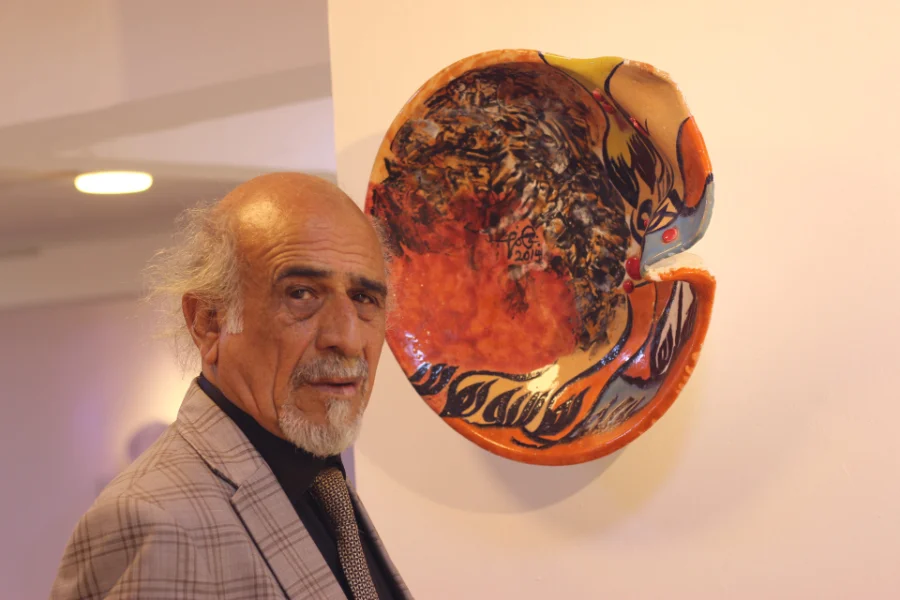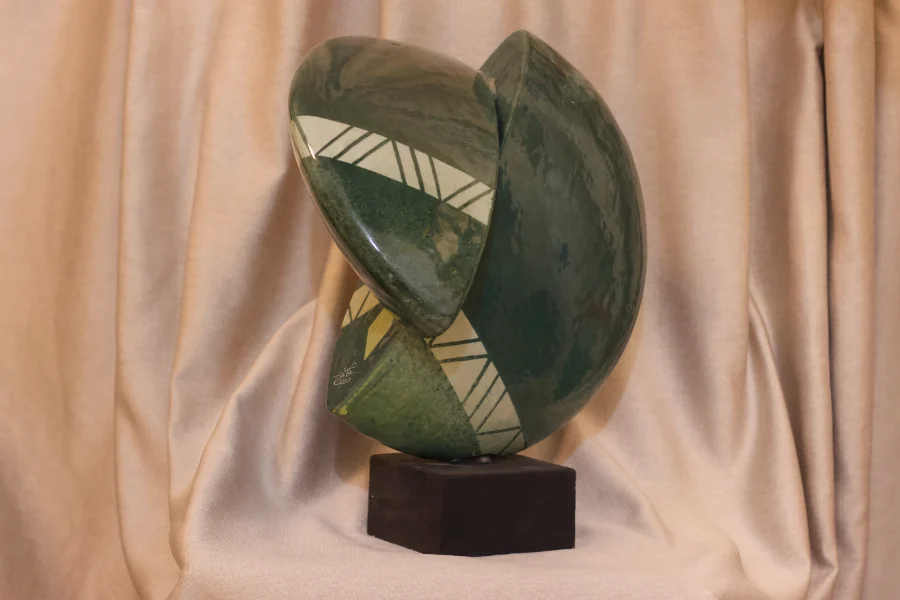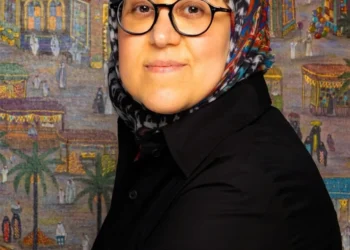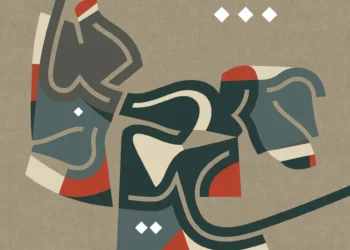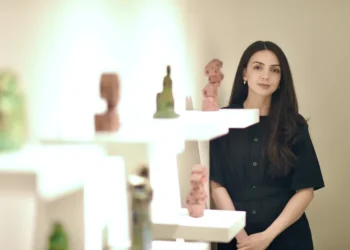HOW DID YOUR JOURNEY WITH CERAMIC ART BEGIN, AND WHAT DROVE YOU TO CHOOSE THIS PARTICULAR MEDIUM AS YOUR CREATIVE IDENTITY?
Since childhood, I was attached to drawing with pens and sketching on walls. I dreamt of becoming a painter during my primary school years. My participation in school exhibitions and winning several encouraging prizes motivated me to keep going. A fortunate coincidence was that my art teacher in high school was the renowned Iraqi artist Nu’man Hadi, now based in Belarus. He opened vast artistic worlds for me, including painting, sculpture, and exposure to key Iraqi and international art experiences. With his guidance, I was able to hold my first solo exhibition in 1972 while still a secondary school student. It included many drawings and sculptures and received significant public attention, marking the first exhibition in my hometown of Mahmoudiyah. This event had a lasting impact on me and led me to study art at the College of Fine Arts. Although I initially wanted to pursue painting, I was assigned to the ceramics department and ended up graduating with distinction.
CAN YOU TELL US ABOUT YOUR EXPERIENCE WITH THE MA’OUN EXHIBITION, THE THEMES YOU WANTED TO CONVEY, AND HOW IT WAS RECEIVED BY AUDIENCES AND CRITICS?
Ma’oun was my second exhibition after my first at the Iraqi Ministry of Culture. It was a joint show with ceramicist and sculptor Mahmoud Ajami. Each of us presented 51 ceramic pieces, totaling 102 works under the title Tales of Clay and Fire, a name inspired by the ceramic-making process itself. While we both shared a focus on cultural heritage, each of us had our unique approach. Mahmoud Ajami presented unglazed pottery, while I later launched my solo Ma’oun exhibition, where the term “ma’oun” (meaning vessel) unified the collection. Most pieces were drawn from folk and civilizational heritage, also incorporating the aesthetics of Arabic calligraphy. The exhibition received strong engagement from the artistic and cultural communities, particularly from art critics.
YOUR THIRD EXHIBITION, TALES OF CLAY AND FIRE, SHOWED A SPECIAL TOUCH OF INNOVATION. HOW DID YOU DEVELOP YOUR IDEAS AND METHODS FOR THIS ONE, AND WHAT SETS IT APART?
While most artists aim to exhibit in Baghdad, I made the deliberate decision to head south, specifically to Basra, for my third exhibition titled Tales of Clay and Fire. The exhibition was well-received at the provincial level, and its success extended to other Iraqi provinces, including Baghdad.
THROUGH YOUR WORK, HOW HAVE YOU COMBINED IRAQI HERITAGE WITH MODERN TECHNIQUES, AND WHAT HAS BEEN THE BIGGEST CHALLENGE IN DOING SO?
Traditional ceramics in Iraq were primarily functional, used in daily life. However, with my expertise and technical skill, I was able to transform this beautiful, versatile material into a cultural and artistic product. I took what was once a vessel for eating and turned it into an object that invites aesthetic appreciation, something to decorate walls and public spaces with deeper cultural meaning.
IN YOUR VIEW, HOW CAN CONTEMPORARY CERAMICISTS EXPRESS NATIONAL IDENTITY THROUGH THEIR WORK, AND WHAT IMPACT DOES THIS HAVE ON PRESERVING AUTHENTIC CULTURE IN TODAY’S WORLD?
When a ceramicist has a deep historical background and strong folk traditions to draw upon, they should use these elements to reinforce national identity. This is what gives their art an authentic character, even when expressed through modern approaches.
CAN YOU WALK US THROUGH YOUR CREATIVE PROCESS WHEN DESIGNING A CERAMIC PIECE, AND HOW DO INTELLECTUAL AND ARTISTIC ELEMENTS INTERSECT IN YOUR WORK?
Every creative process starts with an idea. Then, a design is developed based on the requirements of the commissioned project. The design must align with the environment and space where the artwork will be installed. I study this carefully to ensure that the work reflects elements consistent with its actual setting.
HOW DO YOU SEE CERAMIC ART CONTRIBUTING TO CULTURAL EXCHANGE AMONG ARAB NATIONS, CONSIDERING ITS DEEP HISTORICAL AND CULTURAL ROOTS?
To introduce this art to the Arab world, we need more ceramic art gatherings and exchange programs across the region. Iraq has had a good example through the establishment of craft centers and intergenerational workshops, where even foreign artisans have been invited to teach. Cultural weeks between Arab countries also play a vital role in enhancing this exchange.
WHAT ADVICE DO YOU HAVE FOR YOUNG ARAB ARTISTS WHO WISH TO MASTER CERAMICS, PARTICULARLY IN TERMS OF TECHNIQUE, IDENTITY, AND CREATIVE SUSTAINABILITY?
First and foremost, every Arab nation has its own rich cultural and civilizational heritage. Young artists should draw their inspiration from this heritage, as it’s the true source of our identity.
HOW DO YOU SEE THE FUTURE OF CERAMIC ART IN IRAQ AND THE ARAB WORLD, AND WHAT ARE THE OPPORTUNITIES AND THREATS IT MAY FACE?
I believe ceramics has a promising future even with modern technology entering the field because its strength lies in its deep historical roots.
DO YOU HAVE ANY UPCOMING PROJECTS OR INITIATIVES TO DEVELOP CERAMIC ART OR SUPPORT YOUNG ARTISTS, SUCH AS EXHIBITIONS, WORKSHOPS, OR EDUCATIONAL PROGRAMS?
As a member of the Iraqi Artists Association’s administrative board, we’ve been able to organize an annual ceramics exhibition and invite Arab ceramicists to participate. For youth, we also launched a dedicated exhibition called the Ishtar Prize, which serves as both a motivational and financial support system for emerging artists.
HOW CAN GOVERNMENTS AND CULTURAL INSTITUTIONS SUPPORT THE CERAMICS INDUSTRY AND PROVIDE A NURTURING ENVIRONMENT FOR DEVELOPING SKILLS AND SUSTAINABLE ARTISTIC INNOVATION?
Iraq was a pioneer in supporting ceramic art by establishing vocational training centers, including ones focused on ceramics. Although we aspired to open branches across the country, the project was halted. However, we succeeded in opening the Institute of Folk Crafts and Arts, which remains a key incubator for developing skills and fostering sustainable creativity.
WHAT MESSAGE WOULD YOU LIKE TO LEAVE FOR THE NEXT GENERATION OF CERAMICISTS, TO HELP THEM PRESERVE ARTISTIC HERITAGE WHILE INNOVATING IN WAYS THAT EXPRESS THEIR IDENTITY AND ENRICH ARAB CULTURAL DIALOGUE?
I encourage them to value their civilization, preserve their folk heritage, and draw from it to safeguard their national and artistic identity with the aim of contributing meaningfully to Arab cultural interaction.



























